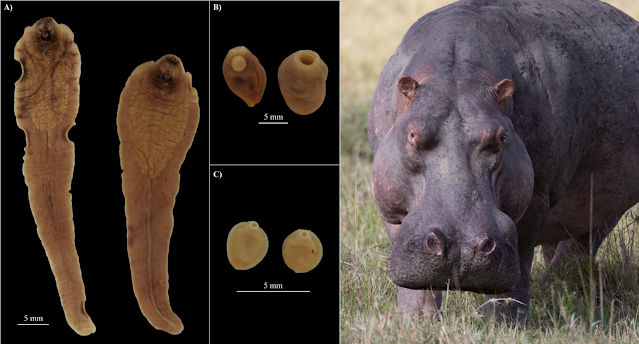Lake Kariba is the largest artificial lake in the world - Initially created in the late-1950s and early-1960s, it has since become inhabited by a wide variety of both endemic and introduced species. One of those introduced species is the water hyacinth (Eichhornia crassipes) which have made themselves quite at home in this giant artificial lake. These floating plants can proliferate at an alarming rate, clogging up the shorelines and sucking up vast quantity of water, nutrient and oxygen. They in turn are prime real estate for a variety of aquatic snails, and serves as breeding ground for many native and introduced snail species in the region.
 |
| Left: (a) Liver fluke Fasciola nyanzae, and (b and c) stomach flukes from hippos, from Fig. 1 of the paper. Right: Photo of hippopotamus in Maasai Mara by Markrosenrosen, used under Creative Commons (CC BY-SA 4.0) license |
So what does that have to do with parasites? For those who have been reading this blog for a while or know something about fluke biology would know the vital role snails play in the life cycles of digenean flukes - specifically the asexual part of their life cycles. Snails can get commandeered by flukes to act as parasite factories that churn out a stream of free-swimming clonal fluke larvae, and an infected snail can end up with 14-39% of their body mass being converted into parasite tissue. This means any place that is hosting an aquatic snail party would inadvertently become a fluke party too.
This study looked at how Lake Kariba has affected the transmission and infection of flukes in hippopotamus. Like any other large animals, hippos are host to a wide variety of parasites, but because they spend so much of their lives in water, this makes them an especially attractive host to a wide range of different flukes. In this study, researchers collected a variety of different aquatic snails from the northeastern shoreline of Lake Kariba, and examined them for fluke infections. They ended up finding six different species of snails that harboured hippo-infecting flukes.
Additionally, they were able to collect flukes directly from a male hippo which was culled near Kariba Town as part of the local wildlife management program. That hippo turned out to be home to a trove of flukes, ranging from long-bodied liver flukes dwelling in the bile ducts, to several hundred bright red stomach flukes that crowded the hippo's stomach. Using some good old-fashion morphological comparisons combined with DNA sequencing, they were able to identify those flukes and match them with the asexual stages which were found in some of the snails they collected.
The liver flukes, which were particularly large for flukes measuring at about 5 centimetres long, were identified as Fasciola nyanzae, a species known to occur in the region and are commonly recorded from hippos. But what's significant here is that whereas the usual snail host for F. nyanzae is Radix natalensis, a snail species which is native to the region, at Lake Kariba this liver fluke has also recruit two additional introduced snail species to serve as parasite factories to do its asexual reproductive biddings. This includes Radix plicatula from Asia, and Pseudosuccinea columella from North America. In fact, the invasive P. columella snail seems to be an even more receptive host to the hippo liver fluke than the native snails. What's more, F. nyanzae is not the only fluke that has taken a liking to the introduced snails. It seems that those bright red hippo stomach flukes also readily use both native and introduced snails for their asexual reproduction.
In addition, by examining the aquatic snails, the researchers were able to detect other flukes species which they didn't record from that male hippo they dissected, but are likely to be circulating in the local hippopotamus population. One of which was a species of hippo blood flukes (Schistosoma edwardiensis). Unlike the liver fluke or the stomach fluke, this blood fluke has only been found in native snails so far, but two of those snails were from the Bulinus genus, which has never recorded as hosts for S. edwardiensis before. This indicates that the fluke may be more prevalent and flexible about what snails it uses as hosts than previously thought.
While the human-infecting species of blood flukes such as Schistosoma mansoni and Schistosoma haematobium are extensively studied due to their public health significance, very little is known about blood flukes which infect wildlife, and information on species such as the blood flukes of hippos, including their ecology and life cycles, are very limited.
The conditions at Lake Kariba have created a haven for snails, which in turn makes it a hotspot for fluke infections, and the presence of introduced snail species exacerbates that. Because on top of contending with the native snails pumping out fluke larvae as they usually have, the hippos now have to deal with the flukes coming from the introduced snails as well. The introduced snails increase the overall parasite load in the environment - this phenomenon is known in disease ecology as "spillback", where an exotic host organism that was introduced to a new area might have started out largely free of its original parasites, but over time, they pick up some of the local parasite species and turn out to be even better hosts for them than their original hosts, thus amplifying the amount of parasite propagules in the environment.
Data and records on how environmental changes affect the epidemiology of wildlife diseases is severely lacking. And in order to obtain such information, it would require collaborations of researchers from many different fields including parasitology, veterinary science, ecology, and conservation biology. This study is but one small piece in a much larger story of how human activities impact the spread and transmission of infectious diseases on this planet.
Reference: